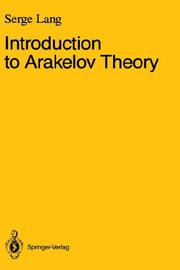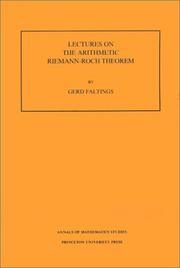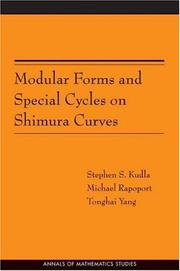| Listing 1 - 10 of 11 | << page >> |
Sort by
|
Book
ISBN: 0511880618 051162395X Year: 1994 Publisher: Cambridge : Cambridge University Press,
Abstract | Keywords | Export | Availability | Bookmark
 Loading...
Loading...Choose an application
- Reference Manager
- EndNote
- RefWorks (Direct export to RefWorks)
Arakelov theory is a new geometric approach to diophantine equations. It combines algebraic geometry in the sense of Grothendieck with refined analytic tools such as currents on complex manifolds and the spectrum of Laplace operators. It has been used by Faltings and Vojta in their proofs of outstanding conjectures in diophantine geometry. This account presents the work of Gillet and Soulé, extending Arakelov geometry to higher dimensions. It includes a proof of Serre's conjecture on intersection multiplicities and an arithmetic Riemann-Roch theorem. To aid number theorists, background material on differential geometry is described, but techniques from algebra and analysis are covered as well. Several open problems and research themes are also mentioned. The book is based on lectures given at Harvard University and is aimed at graduate students and researchers in number theory and algebraic geometry. Complex analysts and differential geometers will also find in it a clear account of recent results and applications of their subjects to new areas.

ISBN: 0387967931 1461269911 1461210313 Year: 1988 Publisher: New York (N.Y.): Springer
Abstract | Keywords | Export | Availability | Bookmark
 Loading...
Loading...Choose an application
- Reference Manager
- EndNote
- RefWorks (Direct export to RefWorks)
Book
ISSN: 03031179 ISBN: 9782856297834 Publisher: Paris Société mathématique de France
Abstract | Keywords | Export | Availability | Bookmark
 Loading...
Loading...Choose an application
- Reference Manager
- EndNote
- RefWorks (Direct export to RefWorks)
Toric varieties --- Arakelov theory --- Variétés toriques --- Arakelov, Théorie d' --- Variétés toriques. --- Arakelov, Théorie d'.

ISBN: 0821820583 Year: 2000 Publisher: Providence, Rhode Island : American Mathematical Society,
Abstract | Keywords | Export | Availability | Bookmark
 Loading...
Loading...Choose an application
- Reference Manager
- EndNote
- RefWorks (Direct export to RefWorks)
Ordered algebraic structures --- 517.544 --- Arakelov theory --- Capacity theory (Mathematics) --- Capacity of a set --- Pluripotential theory --- Arakelov geometry --- Arithmetical algebraic geometry --- Boundary properties of analytic functions. Boundary value problems --- 517.544 Boundary properties of analytic functions. Boundary value problems --- Arakelov theory. --- Arakelov, Théorie d' --- Arakelov, Théorie d'.
Book
ISBN: 3642239781 364223979X Year: 2012 Publisher: Berlin ; Heidelberg : Springer,
Abstract | Keywords | Export | Availability | Bookmark
 Loading...
Loading...Choose an application
- Reference Manager
- EndNote
- RefWorks (Direct export to RefWorks)
This monograph treats one case of a series of conjectures by S. Kudla, whose goal is to show that Fourier of Eisenstein series encode information about the Arakelov intersection theory of special cycles on Shimura varieties of orthogonal and unitary type. Here, the Eisenstein series is a Hilbert modular form of weight one over a real quadratic field, the Shimura variety is a classical Hilbert modular surface, and the special cycles are complex multiplication points and the Hirzebruch–Zagier divisors. By developing new techniques in deformation theory, the authors successfully compute the Arakelov intersection multiplicities of these divisors, and show that they agree with the Fourier coefficients of derivatives of Eisenstein series.
Mathematics --- Physical Sciences & Mathematics --- Algebra --- Shimura varieties. --- Eisenstein series. --- Algebraic cycles. --- Arakelov theory. --- Arakelov geometry --- Cycles, Algebraic --- Series, Eisenstein --- Varieties, Shimura --- Mathematics. --- Number theory. --- Number Theory. --- Number study --- Numbers, Theory of --- Math --- Science --- Automorphic functions --- Arithmetical algebraic geometry --- Geometry, Algebraic
Book
ISBN: 9811517282 9811517274 Year: 2020 Publisher: Singapore : Springer Singapore : Imprint: Springer,
Abstract | Keywords | Export | Availability | Bookmark
 Loading...
Loading...Choose an application
- Reference Manager
- EndNote
- RefWorks (Direct export to RefWorks)
The purpose of this book is to build the fundament of an Arakelov theory over adelic curves in order to provide a unified framework for research on arithmetic geometry in several directions. By adelic curve is meant a field equipped with a family of absolute values parametrized by a measure space, such that the logarithmic absolute value of each non-zero element of the field is an integrable function on the measure space. In the literature, such construction has been discussed in various settings which are apparently transversal to each other. The authors first formalize the notion of adelic curves and discuss in a systematic way its algebraic covers, which are important in the study of height theory of algebraic points beyond Weil–Lang’s height theory. They then establish a theory of adelic vector bundles on adelic curves, which considerably generalizes the classic geometry of vector bundles or that of Hermitian vector bundles over an arithmetic curve. They focus on an analogue of the slope theory in the setting of adelic curves and in particular estimate the minimal slope of tensor product adelic vector bundles. Finally, by using the adelic vector bundles as a tool, a birational Arakelov geometry for projective variety over an adelic curve is developed. As an application, a vast generalization of Nakai–Moishezon’s criterion of positivity is proven in clarifying the arguments of geometric nature from several fundamental results in the classic geometry of numbers. Assuming basic knowledge of algebraic geometry and algebraic number theory, the book is almost self-contained. It is suitable for researchers in arithmetic geometry as well as graduate students focusing on these topics for their doctoral theses.
Algebraic geometry. --- Commutative algebra. --- Commutative rings. --- Functional analysis. --- Algebraic Geometry. --- Commutative Rings and Algebras. --- Functional Analysis. --- Functional calculus --- Calculus of variations --- Functional equations --- Integral equations --- Rings (Algebra) --- Algebra --- Algebraic geometry --- Geometry --- Arakelov theory. --- Arakelov geometry --- Arithmetical algebraic geometry
Book
ISBN: 3030575594 3030575586 Year: 2021 Publisher: Cham, Switzerland : Springer,
Abstract | Keywords | Export | Availability | Bookmark
 Loading...
Loading...Choose an application
- Reference Manager
- EndNote
- RefWorks (Direct export to RefWorks)
Bridging the gap between novice and expert, the aim of this book is to present in a self-contained way a number of striking examples of current diophantine problems to which Arakelov geometry has been or may be applied. Arakelov geometry can be seen as a link between algebraic geometry and diophantine geometry. Based on lectures from a summer school for graduate students, this volume consists of 12 different chapters, each written by a different author. The first chapters provide some background and introduction to the subject. These are followed by a presentation of different applications to arithmetic geometry. The final part describes the recent application of Arakelov geometry to Shimura varieties and the proof of an averaged version of Colmez's conjecture. This book thus blends initiation to fundamental tools of Arakelov geometry with original material corresponding to current research. This book will be particularly useful for graduate students and researchers interested in the connections between algebraic geometry and number theory. The prerequisites are some knowledge of number theory and algebraic geometry.
Number theory. --- Algebraic geometry. --- Number Theory. --- Algebraic Geometry. --- Algebraic geometry --- Geometry --- Number study --- Numbers, Theory of --- Algebra --- Arakelov theory. --- Arakelov geometry --- Arithmetical algebraic geometry --- Geometria algebraica --- Geometria algèbrica --- Geometria --- Anàlisi p-àdica --- Cicles algebraics --- Espais algebraics --- Esquemes (Geometria algebraica) --- Esquemes de grups (Matemàtica) --- Geometria algebraica aritmètica --- Grups algebraics lineals --- Geometria analítica --- Geometria biracional --- Geometria enumerativa --- Geometria tropical --- Homologia --- Singularitats (Matemàtica) --- Superfícies algebraiques --- Teoria de mòduls --- Teoria de la intersecció --- Teoria de Hodge --- Varietats abelianes --- Varietats algebraiques --- Corbes algebraiques --- Funcions abelianes

ISBN: 0691087717 0691025444 1400882478 Year: 2016 Volume: vol 127 Publisher: Princeton, NJ : Princeton University Press,
Abstract | Keywords | Export | Availability | Bookmark
 Loading...
Loading...Choose an application
- Reference Manager
- EndNote
- RefWorks (Direct export to RefWorks)
The arithmetic Riemann-Roch Theorem has been shown recently by Bismut-Gillet-Soul. The proof mixes algebra, arithmetic, and analysis. The purpose of this book is to give a concise introduction to the necessary techniques, and to present a simplified and extended version of the proof. It should enable mathematicians with a background in arithmetic algebraic geometry to understand some basic techniques in the rapidly evolving field of Arakelov-theory.
Algebraic geometry --- Algebraïsche meetkunde --- Geometry [Algebraic ] --- Géométrie algébrique --- Meetkunde [Algebraïsche ] --- Riemann-Roch theorema's --- Riemann-Roch thoerems --- Theoremes de Riemann-Roch --- Geometry, Algebraic. --- Riemann-Roch theorems. --- Theorems, Riemann-Roch --- Algebraic functions --- Geometry, Algebraic --- Geometry --- Addition. --- Adjoint. --- Alexander Grothendieck. --- Algebraic geometry. --- Analytic torsion. --- Arakelov theory. --- Asymptote. --- Asymptotic expansion. --- Asymptotic formula. --- Big O notation. --- Cartesian coordinate system. --- Characteristic class. --- Chern class. --- Chow group. --- Closed immersion. --- Codimension. --- Coherent sheaf. --- Cohomology. --- Combination. --- Commutator. --- Computation. --- Covariant derivative. --- Curvature. --- Derivative. --- Determinant. --- Diagonal. --- Differentiable manifold. --- Differential form. --- Dimension (vector space). --- Divisor. --- Domain of a function. --- Dual basis. --- E6 (mathematics). --- Eigenvalues and eigenvectors. --- Embedding. --- Endomorphism. --- Exact sequence. --- Exponential function. --- Generic point. --- Heat kernel. --- Injective function. --- Intersection theory. --- K-group. --- Levi-Civita connection. --- Line bundle. --- Linear algebra. --- Local coordinates. --- Mathematical induction. --- Morphism. --- Natural number. --- Neighbourhood (mathematics). --- Parameter. --- Projective space. --- Pullback (category theory). --- Pullback (differential geometry). --- Pullback. --- Riemannian manifold. --- Riemann–Roch theorem. --- Self-adjoint operator. --- Smoothness. --- Sobolev space. --- Stochastic calculus. --- Summation. --- Supertrace. --- Theorem. --- Transition function. --- Upper half-plane. --- Vector bundle. --- Volume form.
Book

ISBN: 128305180X 9786613051806 1400839009 9781400839001 9780691142012 0691142017 9780691142029 0691142025 Year: 2011 Publisher: Princeton, NJ
Abstract | Keywords | Export | Availability | Bookmark
 Loading...
Loading...Choose an application
- Reference Manager
- EndNote
- RefWorks (Direct export to RefWorks)
"Modular forms are tremendously important in various areas of mathematics, from number theory and algebraic geometry to combinatorics and lattices. Their Fourier coefficients, with Ramanujan's tau-function as a typical example, have deep arithmetic significance. Prior to this book, the fastest known algorithms for computing these Fourier coefficients took exponential time, except in some special cases. The case of elliptic curves (Schoof's algorithm) was at the birth of elliptic curve cryptography around 1985. This book gives an algorithm for computing coefficients of modular forms of level one in polynomial time. For example, Ramanujan's tau of a prime number P can be computed in time bounded by a fixed power of the logarithm of P. Such fast computation of Fourier coefficients is itself based on the main result of the book: the computation, in polynomial time, of Galois representations over finite fields attached to modular forms by the Langlands program. Because these Galois representations typically have a nonsolvable image, this result is a major step forward from explicit class field theory, and it could be described as the start of the explicit Langlands program. The computation of the Galois representations uses their realization, following Shimura and Deligne, in the torsion subgroup of Jacobian varieties of modular curves. The main challenge is then to perform the necessary computations in time polynomial in the dimension of these highly nonlinear algebraic varieties. Exact computations involving systems of polynomial equations in many variables take exponential time. This is avoided by numerical approximations with a precision that suffices to derive exact results from them. Bounds for the required precision--in other words, bounds for the height of the rational numbers that describe the Galois representation to be computed--are obtained from Arakelov theory. Two types of approximations are treated: one using complex uniformization and another one using geometry over finite fields. The book begins with a concise and concrete introduction that makes its accessible to readers without an extensive background in arithmetic geometry. And the book includes a chapter that describes actual computations"-- "This book represents a major step forward from explicit class field theory, and it could be described as the start of the 'explicit Langlands program'"--
Galois modules (Algebra) --- Class field theory. --- Algebraic number theory --- Galois module structure (Algebra) --- Galois's modules (Algebra) --- Modules (Algebra) --- Arakelov invariants. --- Arakelov theory. --- Fourier coefficients. --- Galois representation. --- Galois representations. --- Green functions. --- Hecke operators. --- Jacobians. --- Langlands program. --- Las Vegas algorithm. --- Lehmer. --- Peter Bruin. --- Ramanujan's tau function. --- Ramanujan's tau-function. --- Ramanujan's tau. --- Riemann surfaces. --- Schoof's algorithm. --- Turing machines. --- algorithms. --- arithmetic geometry. --- arithmetic surfaces. --- bounding heights. --- bounds. --- coefficients. --- complex roots. --- computation. --- computing algorithms. --- computing coefficients. --- cusp forms. --- cuspidal divisor. --- eigenforms. --- finite fields. --- height functions. --- inequality. --- lattices. --- minimal polynomial. --- modular curves. --- modular forms. --- modular representation. --- modular representations. --- modular symbols. --- nonvanishing conjecture. --- p-adic methods. --- plane curves. --- polynomial time algorithm. --- polynomial time algoriths. --- polynomial time. --- polynomials. --- power series. --- probabilistic polynomial time. --- random divisors. --- residual representation. --- square root. --- square-free levels. --- tale cohomology. --- torsion divisors. --- torsion.

ISBN: 1299401023 1400837162 0691125511 0691125503 9781400837168 9780691125503 9780691125510 9781299401020 Year: 2006 Publisher: Princeton, NJ
Abstract | Keywords | Export | Availability | Bookmark
 Loading...
Loading...Choose an application
- Reference Manager
- EndNote
- RefWorks (Direct export to RefWorks)
Modular Forms and Special Cycles on Shimura Curves is a thorough study of the generating functions constructed from special cycles, both divisors and zero-cycles, on the arithmetic surface "M" attached to a Shimura curve "M" over the field of rational numbers. These generating functions are shown to be the q-expansions of modular forms and Siegel modular forms of genus two respectively, valued in the Gillet-Soulé arithmetic Chow groups of "M". The two types of generating functions are related via an arithmetic inner product formula. In addition, an analogue of the classical Siegel-Weil formula identifies the generating function for zero-cycles as the central derivative of a Siegel Eisenstein series. As an application, an arithmetic analogue of the Shimura-Waldspurger correspondence is constructed, carrying holomorphic cusp forms of weight 3/2 to classes in the Mordell-Weil group of "M". In certain cases, the nonvanishing of this correspondence is related to the central derivative of the standard L-function for a modular form of weight 2. These results depend on a novel mixture of modular forms and arithmetic geometry and should provide a paradigm for further investigations. The proofs involve a wide range of techniques, including arithmetic intersection theory, the arithmetic adjunction formula, representation densities of quadratic forms, deformation theory of p-divisible groups, p-adic uniformization, the Weil representation, the local and global theta correspondence, and the doubling integral representation of L-functions.
Arithmetical algebraic geometry. --- Shimura varieties. --- Varieties, Shimura --- Algebraic geometry, Arithmetical --- Arithmetic algebraic geometry --- Diophantine geometry --- Geometry, Arithmetical algebraic --- Geometry, Diophantine --- Arithmetical algebraic geometry --- Number theory --- Abelian group. --- Addition. --- Adjunction formula. --- Algebraic number theory. --- Arakelov theory. --- Arithmetic. --- Automorphism. --- Bijection. --- Borel subgroup. --- Calculation. --- Chow group. --- Coefficient. --- Cohomology. --- Combinatorics. --- Compact Riemann surface. --- Complex multiplication. --- Complex number. --- Cup product. --- Deformation theory. --- Derivative. --- Dimension. --- Disjoint union. --- Divisor. --- Dual pair. --- Eigenfunction. --- Eigenvalues and eigenvectors. --- Eisenstein series. --- Elliptic curve. --- Endomorphism. --- Equation. --- Explicit formulae (L-function). --- Fields Institute. --- Formal group. --- Fourier series. --- Fundamental matrix (linear differential equation). --- Galois group. --- Generating function. --- Green's function. --- Group action. --- Induced representation. --- Intersection (set theory). --- Intersection number. --- Irreducible component. --- Isomorphism class. --- L-function. --- Laurent series. --- Level structure. --- Line bundle. --- Local ring. --- Mathematical sciences. --- Mathematics. --- Metaplectic group. --- Modular curve. --- Modular form. --- Modularity (networks). --- Moduli space. --- Multiple integral. --- Number theory. --- Numerical integration. --- Orbifold. --- Orthogonal complement. --- P-adic number. --- Pairing. --- Prime factor. --- Prime number. --- Pullback (category theory). --- Pullback (differential geometry). --- Pullback. --- Quadratic form. --- Quadratic residue. --- Quantity. --- Quaternion algebra. --- Quaternion. --- Quotient stack. --- Rational number. --- Real number. --- Residue field. --- Riemann zeta function. --- Ring of integers. --- SL2(R). --- Scientific notation. --- Shimura variety. --- Siegel Eisenstein series. --- Siegel modular form. --- Special case. --- Standard L-function. --- Subgroup. --- Subset. --- Summation. --- Tensor product. --- Test vector. --- Theorem. --- Three-dimensional space (mathematics). --- Topology. --- Trace (linear algebra). --- Triangular matrix. --- Two-dimensional space. --- Uniformization. --- Valuative criterion. --- Whittaker function.
| Listing 1 - 10 of 11 | << page >> |
Sort by
|

 Search
Search Feedback
Feedback About UniCat
About UniCat  Help
Help News
News